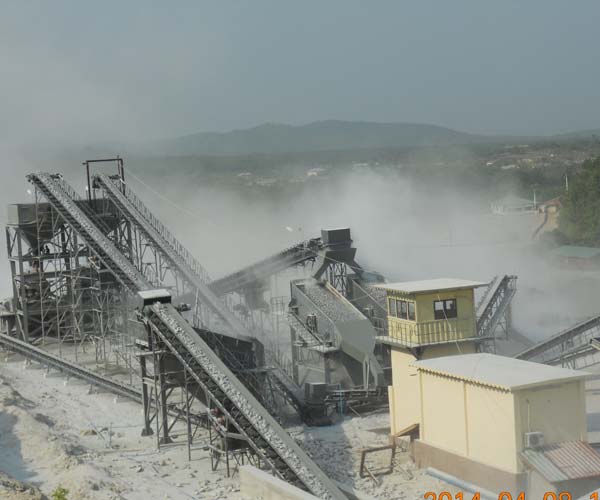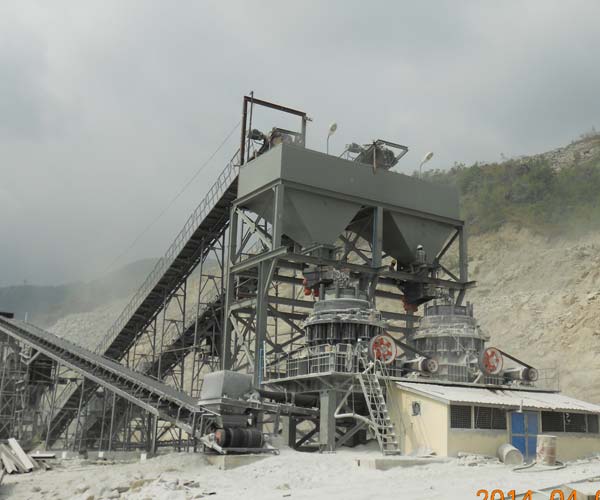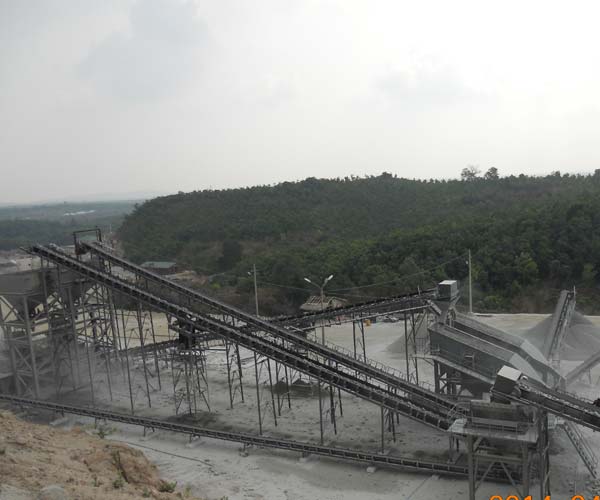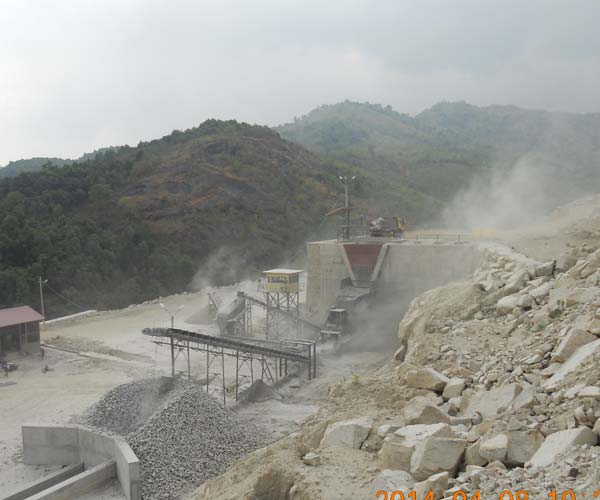
Stone quarry crushers play a pivotal role in breaking down large rocks into smaller, more manageable sizes. The efficiency and performance of these crushers directly impact the productivity and profitability of the entire quarry operation.Optimizing crusher performance is not only about maximizing output but also about minimizing downtime, reducing operational costs, and ensuring a sustainable and environmentally responsible approach.
24 Online Service

Stone quarry crushers play a pivotal role in the extraction and processing of raw materials for construction and infrastructure projects. As the backbone of the mining industry, these crushers come in various types, each designed to serve a specific purpose in the intricate process of breaking down large rocks into smaller, more manageable pieces.
Jaw crushers stand as the workhorses of the quarrying industry, serving as primary crushers that initially break down the blasted rock. These crushers consist of a fixed jaw and a movable jaw, with the movement of the latter creating a squeezing action against the fixed jaw. This process effectively reduces the size of large rocks into smaller, more manageable pieces.
The primary function of jaw crushers is to facilitate the crushing of exceptionally hard materials, making them ideal for the initial stages of the quarrying process. Recent innovations in jaw crusher technology have focused on enhancing efficiency, reducing maintenance requirements, and improving safety features. For example, some modern jaw crushers incorporate advanced automation systems, ensuring optimal performance and minimizing downtime.
Cone crushers are synonymous with versatility and efficiency in the world of stone quarrying. These crushers use a cone-shaped chamber to crush rocks between gyrating spindles. The adjustable gap between the cone and the enclosing concave allows for the production of various-sized materials.
The primary function of cone crushers is to produce finely crushed materials, making them well-suited for secondary and tertiary crushing stages in the quarrying process. Recent advancements in cone crusher technology include improvements in the design of the crushing chamber, which contributes to better particle shape and size distribution. Additionally, automation features have been integrated to optimize the overall operational efficiency of cone crushers.
In scenarios where the goal is to produce high-quality aggregates for construction projects, impact crushers come into play. These crushers utilize the principle of rapid impact to crush materials. A high-speed rotor hurls the rocks against a solid surface, resulting in the generation of fine particles.
The primary function of impact crushers is to produce cubical-shaped products and meet stringent specifications for concrete and asphalt production. Recent innovations in impact crusher technology focus on enhancing wear resistance, reducing maintenance requirements, and improving overall efficiency. Some models now feature adjustable settings to control the size and shape of the final product, providing quarry operators with greater flexibility.
The quarrying industry has witnessed significant advancements in crusher technology, driven by a constant quest for improved efficiency, reduced environmental impact, and enhanced safety. One notable innovation is the integration of automation and remote monitoring systems. Quarry operators can now monitor and control crusher operations from a centralized location, leading to better efficiency and lower operating costs.
Furthermore, advancements in materials and design have contributed to the development of more durable and wear-resistant components. This not only extends the lifespan of the crushers but also reduces the frequency of maintenance, improving overall operational uptime.
Another noteworthy advancement is the incorporation of data analytics and predictive maintenance technologies. Through the analysis of data generated by sensors and monitoring systems, quarry operators can proactively address potential issues, preventing costly downtime and unplanned maintenance.

The efficiency and effectiveness of these crushers are crucial for the success of quarry operations. To evaluate and enhance their performance, various key performance metrics are employed.
Throughput, often referred to as the crusher’s production capacity, measures the quantity of material processed within a specified time frame. It is a fundamental metric that directly influences the overall performance of a stone quarry crusher. A high throughput indicates a robust and productive crusher, capable of handling large volumes of material efficiently. This metric is crucial for meeting production targets and ensuring a steady supply of processed material for downstream operations.
Efficiency is a key metric that assesses how effectively a crusher converts input energy into output material. It is typically expressed as a percentage and reflects the overall effectiveness of the crushing process. High efficiency ensures that the energy invested in crushing rocks is utilized optimally, resulting in more material processed per unit of energy input. Efficient crushers contribute to lower operational costs and reduced environmental impact, making them essential for sustainable quarrying practices.
Power consumption is a critical metric for evaluating the energy efficiency of stone quarry crushers. It directly impacts operational costs and environmental sustainability. Crushers with high power consumption not only increase electricity bills but also contribute to carbon footprints. Conversely, efficient crushers with lower power consumption reduce operational costs and promote environmental stewardship. Striking the right balance between performance and sustainability is vital for the long-term viability of quarry operations.
The reliability and longevity of stone quarry crushers depend significantly on their maintenance requirements. Regular maintenance is essential to prevent unexpected breakdowns, extend the lifespan of equipment, and minimize downtime. Metrics related to maintenance, such as mean time between failures (MTBF) and mean time to repair (MTTR), provide valuable insights into the overall reliability and availability of the crusher. Low maintenance requirements are indicative of a well-designed and durable machine, contributing to continuous and uninterrupted production.
Particle size distribution is a crucial metric that characterizes the range of particle sizes produced by a stone quarry crusher. The ideal particle size distribution is determined by the specific requirements of downstream processes, such as screening, grinding, and sorting. Crushers that produce a consistent and well-controlled particle size distribution enhance the efficiency of subsequent operations. Fine-tuning this metric ensures that the processed material meets the specifications of end-users, whether it be for concrete production, road construction, or other applications.
While each metric individually contributes to overall crusher performance, their interplay is what truly defines the effectiveness of a stone quarry crusher. A balance must be struck among these metrics to achieve optimal results. For instance, a crusher with high throughput may be less efficient if power consumption is excessively high. Similarly, an efficient crusher may face reliability issues if maintenance requirements are neglected.
To strike the right balance, modern crushers often leverage advanced technologies and automation. Real-time monitoring systems and sensors enable operators to track and adjust key metrics on the fly, optimizing crusher performance. For example, closed-loop control systems can adjust the crusher settings based on real-time measurements of particle size distribution, ensuring a consistent and desired output.

Stone quarry crushers play a pivotal role in the mining and construction industries, breaking down large rocks into smaller, more manageable sizes for various applications. However, the performance of these crushers can be influenced by a myriad of factors, ranging from geological considerations to operational practices.
Geological conditions significantly impact the performance of stone quarry crushers. The composition and structure of the rock formations in a quarry can affect the efficiency and effectiveness of the crushing process. For instance, the hardness, abrasiveness, and fragmentation of rocks are critical geological factors. Harder rocks may require more energy to be crushed, impacting the overall efficiency of the crushing operation.
Furthermore, the presence of impurities and variations in rock consistency can pose challenges to crushers. Variability in geological formations may result in uneven feed to the crushers, affecting their performance and leading to increased wear and tear on the equipment.
Understanding the characteristics of the raw materials being processed is essential for optimizing crusher performance. Different types of crushers are designed to handle specific types of materials, and using the wrong type of crusher for a particular material can result in suboptimal performance.
The size, shape, and gradation of the feed material are crucial considerations. Irregularly shaped or oversized rocks can cause blockages and uneven wear on the crusher components. Additionally, the moisture content of the material can impact crushing efficiency, with overly wet or sticky materials often leading to clogging and reduced throughput.
Beyond geological and raw material factors, the operational aspects of a stone quarry also play a significant role in crusher performance. Factors such as crusher design, choke feeding, and the selection of appropriate crushing chambers are critical in achieving optimal results.
Properly sizing the crushers for the specific application is essential. Undersized crushers may struggle to meet production demands, leading to increased wear and reduced overall efficiency. On the other hand, oversized crushers may result in unnecessary energy consumption and operational costs.
Choke feeding, where the crusher cavity is kept full without overloading, can enhance performance by maximizing the impact on the material being crushed. This helps maintain a steady feed rate and promotes efficient crushing.
Perhaps the most crucial aspect of ensuring consistent and reliable crusher performance is the implementation of proper maintenance practices. Regular inspections, routine maintenance, and timely repairs are imperative to prevent unexpected breakdowns and costly downtime.
Wear parts, such as crusher liners and impact bars, need to be monitored and replaced as needed to maintain optimal performance. Lubrication of all moving parts is critical to reduce friction and wear. Neglecting maintenance can lead to increased operating costs, decreased productivity, and a higher risk of catastrophic failures.
The foundation of crusher optimization lies in selecting the right equipment for the job. Different types of crushers cater to specific needs, and understanding the material characteristics is crucial. For instance, cone crushers are ideal for hard and abrasive materials, while impact crushers work well with softer rocks. Tailoring the equipment to the quarry’s unique requirements is the first step towards optimization.
Fine-tuning the crusher settings is an ongoing process that directly impacts performance. The CSS (Closed Side Setting) and eccentric speed are critical parameters. The CSS determines the product size distribution, while adjusting the eccentric speed can optimize particle shape. Regularly monitoring and adjusting these settings can significantly improve the crusher’s efficiency.
Uneven feed distribution can lead to inconsistent crusher performance and premature wear. Implementing measures to ensure a uniform feed, such as vibrating feeders or conveyor belt speed control, prevents overloading and maximizes crusher efficiency.
Maintaining a consistent choke feed is essential for optimal crusher performance. Choke feeding reduces wear on the liners and ensures the crusher operates at full capacity, resulting in improved product quality and production rates.
Regular monitoring of key parameters, such as temperature, oil pressure, and power draw, is crucial for identifying potential issues before they escalate. Advanced monitoring systems can provide real-time data, enabling timely intervention and preventive maintenance.
Scheduled maintenance is vital for prolonged crusher life and reliable performance. Regular inspections should cover wear components such as liners, bearings, and belts. Timely replacements and adjustments can prevent unscheduled downtime and reduce overall maintenance costs.
Adequate lubrication is the lifeblood of crushers. Implementing a strict lubrication schedule and using the right type and amount of lubricant is paramount. Proper lubrication reduces friction, minimizes wear, and extends the operational life of critical components.
Our Projects
Copyright © ZENITH, All Right Reserved.
